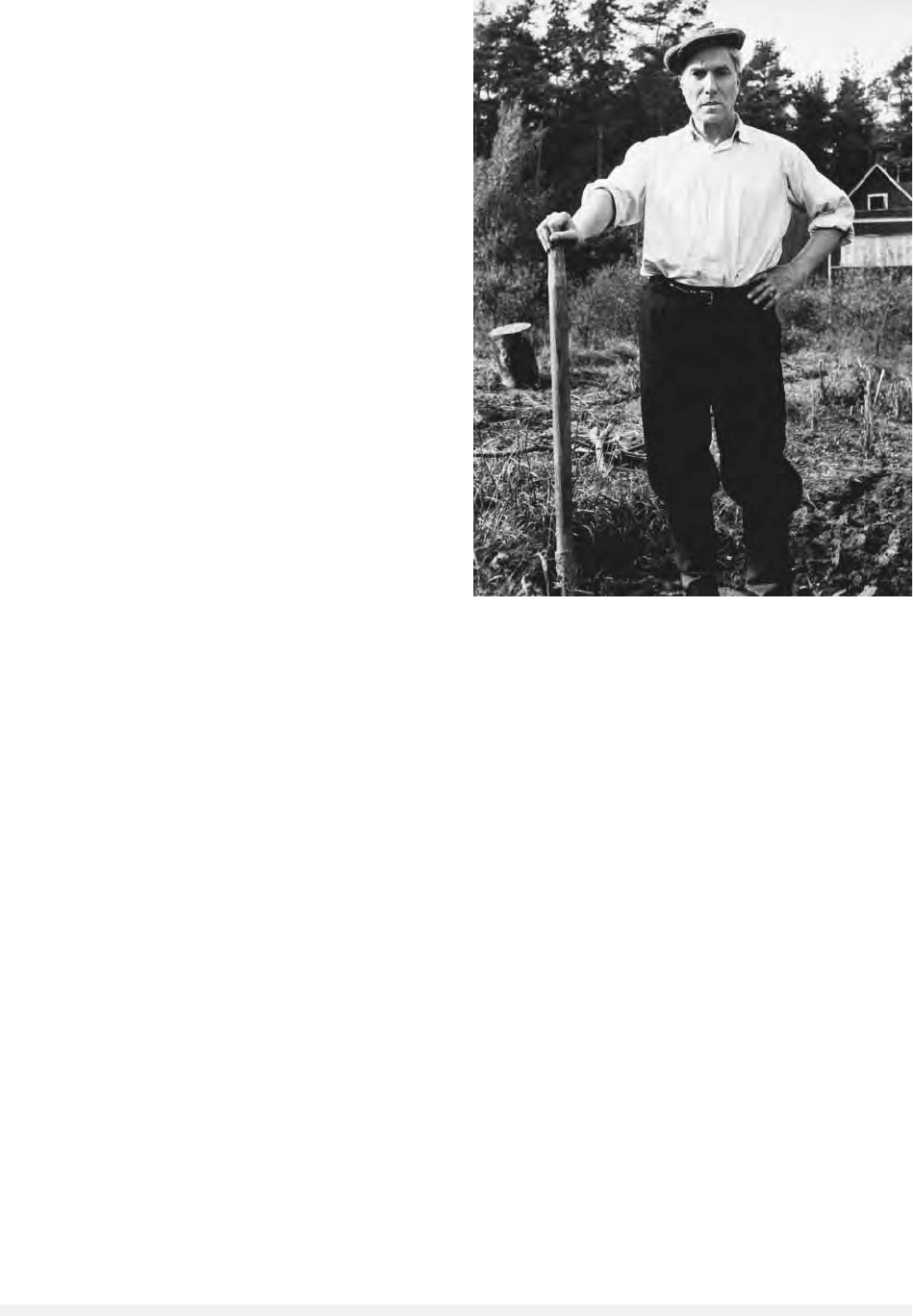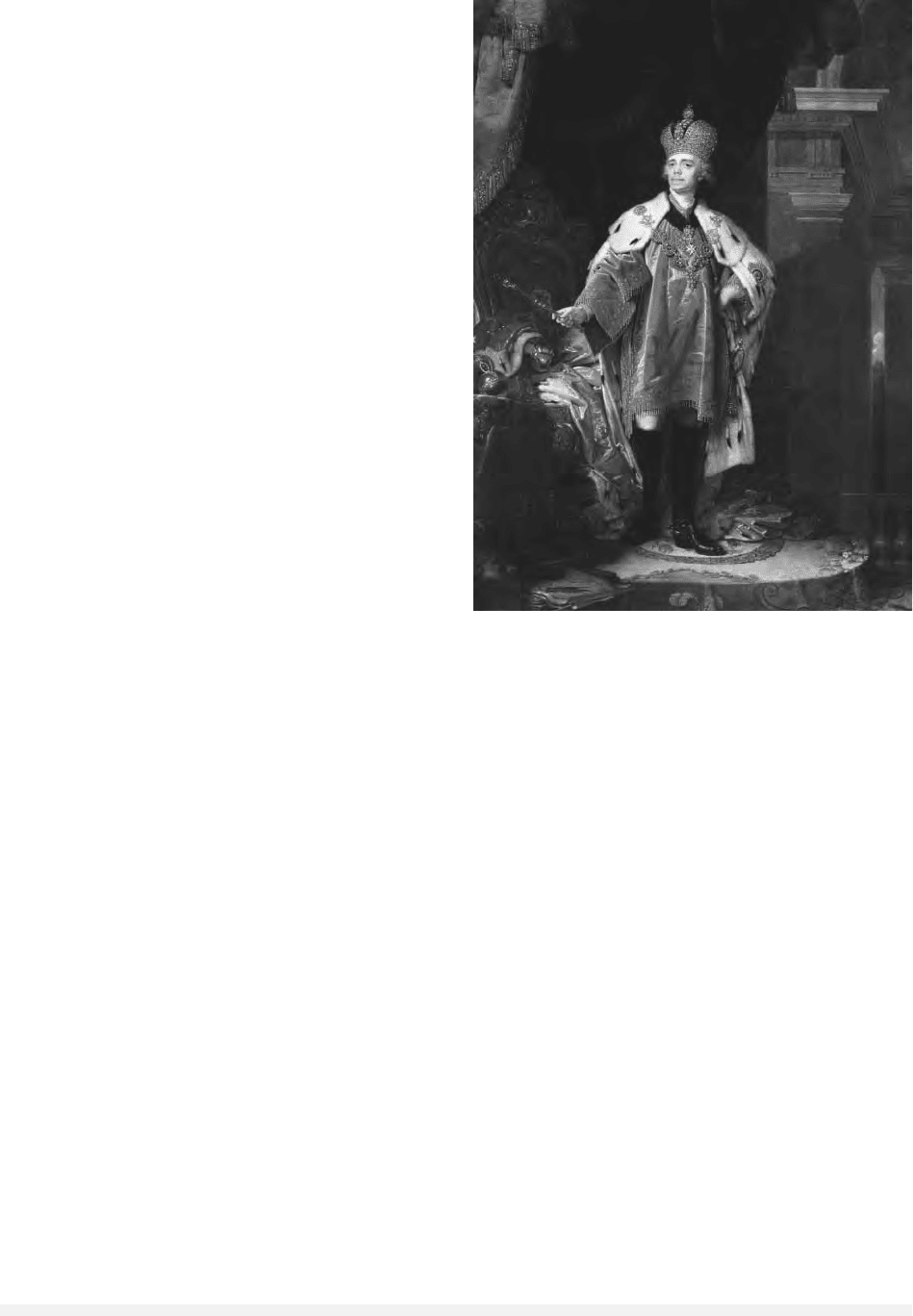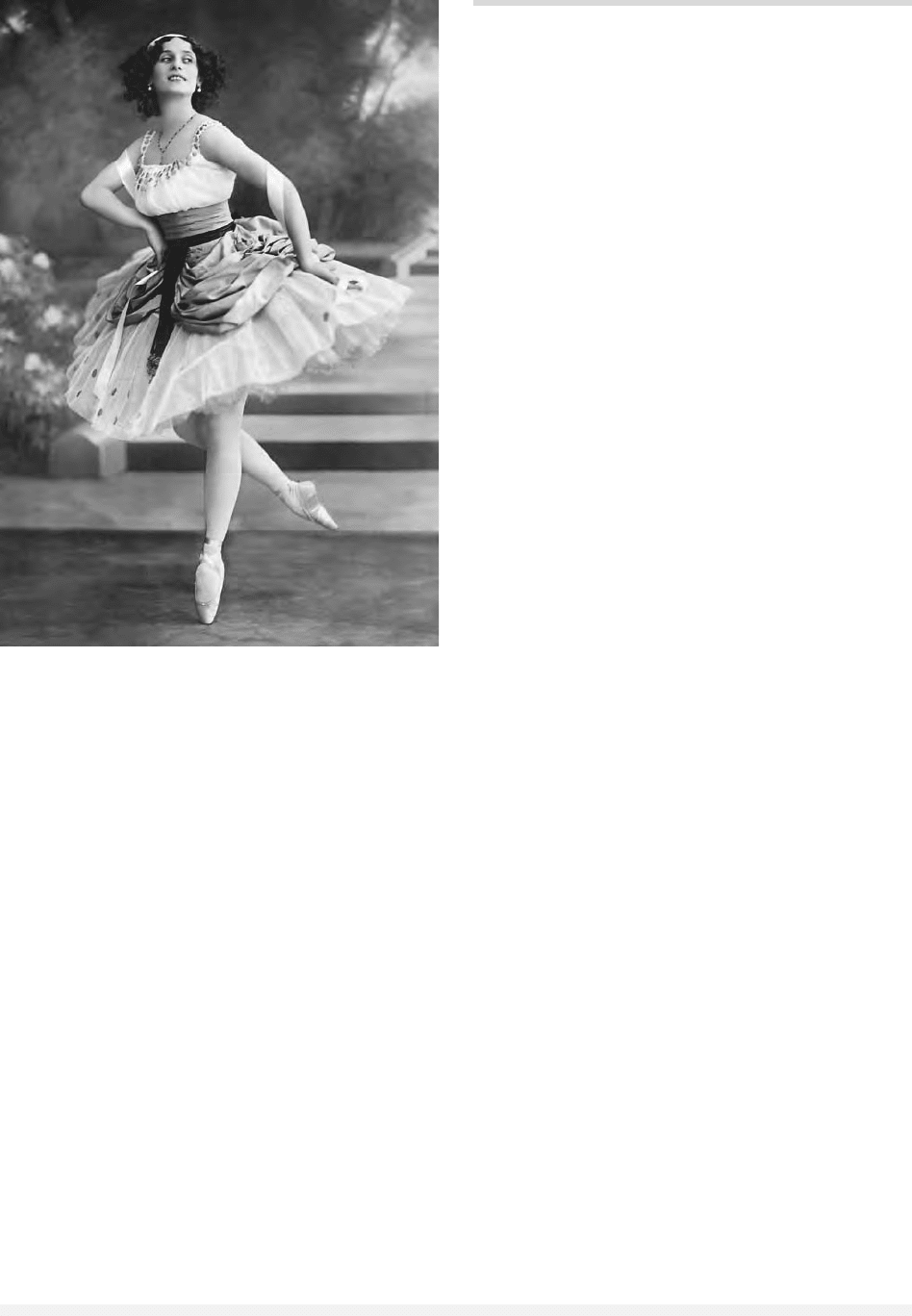Encyclopedia of Russian History
Подождите немного. Документ загружается.


Mawdsley, Evan, and White, Stephan. (2000). The Soviet
Elite from Lenin to Gorbachev: The Central Committee
and its Members, 1917–1991. Oxford: Oxford Uni-
versity Press.
McNeal, Robert H., ed. (1974). Resolutions and Decisions
of the Communist Party of the Soviet Union. 4 vols.
Toronto: University of Toronto Press.
Meissner, Boris. (1975). The Communist Party of the So-
viet Union: Party Leadership, Organization, and Ideol-
ogy. Westport, CT: Greenwood.
Ponomaryov, Boris N., et al. (1960). History of the Com-
munist Party of the Soviet Union. Moscow: Foreign
Languages Publishing House.
Rigby, T. H. (1990). The Changing Soviet System: Mono-
Organizational Society from Its Origins to Gorbachev’s
Restructuring. Aldershot, UK: E. Elgar.
Schapiro, Leonard B. (1960). The Communist Party of the
Soviet Union. New York: Random House.
Schapiro, Leonard B. (1977). Origin of the Communist Au-
tocracy: Political Opposition in the Soviet State, First
Phase, 1917–1922, 2nd ed. Cambridge, MA: Harvard
University Press.
Stalin, Joseph V. (1947). Problems of Leninism. Moscow:
Foreign Languages Publishing House.
R
OBERT
V. D
ANIELS
PARTY OF RUSSIAN UNITY AND ACCORD
The Party of Russian Unity and Accord (Partiya
Rossiyskogo Yedinstva i Soglasiya, or PRES) was
founded for the 1993 elections as a regional vari-
ant of the ruling party. Its founder, a visible politi-
cian of the early Boris Yeltsin period, deputy prime
minister Sergei Shakhrai, was at the time the head
of the State Committee on Federal and Nationalist
Issues, whose apparatus was used in the provinces
as a base for party construction. Even the con-
stituent assembly of the PRES in October 1993 took
place not in Moscow but in Novgorod. The party
proclaimed as its goal the preservation of Russia’s
unity through securing equal rights of the subjects
of the Russian Federation. The PRES list at the
1993 elections was headed by Shakhrai; Alexander
Shokhin, deputy prime minister and an economist;
and Konstantin Zatulin, chair of the association En-
trepreneurs for a New Russia. Two federal minis-
ters were included on it as well: Yuri Kalmykov
and Gennady Melikian, and also the future public
figures Valery Kirpichnikov (minister of regional
politics in 1998–1999), Vladimir Tumanov (chair
of the Constitutional Court in 1995–1996), and
others. The list received 3.6 million votes (6.7%,
seventh place), mainly in the national republics, and
eighteen mandates; four PRES candidates in single-
mandate districts were elected. The PRES fraction
started out with thirty Duma delegates and ended
with twelve, due to disagreement over the Chech-
nya question as well as interfractional maneuver-
ing. During the 1995 campaign, PRES first joined
with Our Home Is Russia (NDR), but then made its
own list with Shakhrai at the head and registered
twenty-three candidates in the districts. However,
Shakhrai’s political stardom was already on the de-
cline, and when he left the State Committee on Fed-
eral and Nationalist Issues, he lost his base in the
provinces. The list received 246,000 votes (0.4%),
and in the majority districts only Shakhrai won,
joining with the group Russian Regions. In the
1999 elections, the PRES did not participate inde-
pendently. Shakhrai, joining with Yuri Luzhkov,
was included in the original version of the Father-
land—All Russia (OVR) list, but excluded at the
bloc’s congress. In May 2000 the PRES merged into
Unity when the latter was restructured from a
movement into a party.
See also: SHAKHRAI, SERGEI MIKHAILOVICH; UNITY
(MEDVED) PARTY
BIBLIOGRAPHY
McFaul, Michael. (2001). Russia’s Unfinished Revolution:
Political Change from Gorbachev to Putin. Ithaca, NY:
Cornell University.
McFaul, Michael, and Markov, Sergei. (1993). The Trou-
bled Birth of Russian Democracy: Parties, Personalities,
and Programs. Stanford, CA: Hoover Institution
Press.
Reddaway, Peter, and Glinski, Dmitri. (2001). The Tragedy
of Russia’s Reforms: Market Bolshevism Against Democ-
racy. Washington, DC: U.S. Institute of Peace Press.
N
IKOLAI
P
ETROV
PASSPORT SYSTEM
For the first time since the revolution, the Soviet
regime introduced an internal passport system in
December 1932. Most rural residents were not
given passports, and peasants acquired the auto-
matic right to a passport only during the 1970s.
The OGPU/NKVD (Soviet military intelligence ser-
vice and secret police), which administered the pass-
port system, initially issued these documents to
PASSPORT SYSTEM
1143
ENCYCLOPEDIA OF RUSSIAN HISTORY

persons over sixteen years of age who lived in
towns, workers’ settlements, state farms, and con-
struction sites. They were required to obtain and
register their passport with the police, who would
then issue the necessary residence permit.
People who did not qualify for a passport were
evicted from their apartments and denied the right
to live and work within city limits. The categories
of people who were denied a passport and urban
residence permit included: the disenfranchised, ku-
laks or the dekulakized, all persons with a crimi-
nal record, persons not engaged in socially useful
work, and family members of the aforementioned
categories. The stated purpose of the new passport
system was to relieve the urban population of per-
sons not engaged in socially useful labor, as well
as hidden kulak, criminal, and other antisocietal el-
ements.
Some scholars note that the passport law
emerged in response to the massive urban migra-
tion that followed the 1932 famine. The resulting
movement of peasants from the countryside into
the cities strained the urban rationing and supply
systems. The selective distribution of passports of-
fered a solution to this crisis by restricting urban
residency and limiting access to city services and
goods. Other scholars emphasize that the passport
system was established to manage the urban pop-
ulation. Passports emerged as an instrument of re-
pression and police control. By issuing passports,
the state could more precisely identify, order, and
purge the urban population. Nonetheless, scholars
agree that the system of internal passports and ur-
ban residence permits sought to remove unreliable
elements from strategic cities, limit the flow of peo-
ple into these cities, and relieve the pressure on the
urban rationing and supply systems.
Passports categorized the Soviet population
into distinct groups with varying rights and priv-
ileges. The internal passport recorded citizens’ so-
cial position or class, occupation, nationality, age,
sex, and place of residence. The identity fixed on a
person’s passport determined where that individ-
ual could work, travel, and live. Only those with
certain social, ethnic, and occupational identities
were allowed residency in privileged cities, indus-
trial sites, and strategic border and military areas.
The passport also tied individuals to geographic ar-
eas and restricted their movements.
In the process of assigning passports, Soviet po-
lice removed dangerous, marginal, and anti-Soviet
elements from the major cities. Many people fled
the cities as passports were being introduced, fear-
ful that they would arrested by the police as so-
cially harmful elements. Passportization operations
were also used to purge the western borderlands
of Polish, German, Finnish, and other anti-Soviet
groups.
In the initial phases, the internal passport and
urban registration system often functioned in an
irregular and erratic manner. Many people cir-
cumvented the system by forging passports, and
others lived in towns without a valid passport.
See also: FAMINE OF 1932-1933; KULAKS; MIGRATION;
STATE SECURITY, ORGANS OF
BIBLIOGRAPHY
Alexopoulos, Golfo. (1998). “Portrait of a Con Artist as
a Soviet Man.” Slavic Review 57:774–790.
Fitzpatrick, Sheila. (1994). Stalin’s Peasants. New York:
Oxford University Press.
Fitzpatrick, Sheila. (1999). Everyday Stalinism. New York:
Oxford University Press.
Kessler, Gijs. (2001). “The Passport System and State
Control over Population Flows in the Soviet Union,
1932–1940.” Cahiers du monde Russe 42:477–504.
G
OLFO
A
LEXOPOULOS
PASTERNAK, BORIS LEONIDOVICH
(1890–1960), poet, writer, translator.
Boris Leonidovich Pasternak was the most
prominent figure of his literary generation, a great
poet deeply connected with his age. His work un-
folded during a period of fundamental changes in
Russian cultural, social, and political history. It is
therefore no wonder that many of his works, and
most notably his novel, Doctor Zhivago, are imbued
with the spirit of history and relate its effect on the
lives, thoughts, and preoccupations of his contem-
poraries. In 1958 he was awarded the Nobel Prize
for his achievements in lyrical poetry and the great
Russian epic tradition.
Pasternak was born in Moscow into a highly
cultured Jewish family. His father, Leonid Paster-
nak, was a well-known impressionist painter and
professor at the Moscow School of Painting; his
mother was an accomplished pianist. During his
formative years, Pasternak studied music and phi-
losophy but abandoned them for literature. At the
PASTERNAK, BORIS LEONIDOVICH
1144
ENCYCLOPEDIA OF RUSSIAN HISTORY

beginning of his literary career, he was associated
with the artistic avant-garde, and his modern sen-
sibility was strongly expressed in his first two vol-
umes of poetry, Twin in the Clouds (1914) and Above
the Barriers (1916), and in his early experiments in
fiction (1911–1913). Most of Pasternak’s works
written between 1911 and 1931 explore possibili-
ties far beyond realism and are characterized by
dazzling metaphorical imagery and complex syn-
tax reminiscent of Cubo-Futurist poetry, associated
especially with Vladimir Mayakovsky. Pasternak’s
cycle, My Sister-Life, published in 1922, is recog-
nized as his most outstanding poetic achievement.
Pasternak’s initial support of the Bolshevik
Revolution of 1917 vanished when the new regime
revealed its authoritarian and ruthless features.
Like many other Soviet writers during the 1920s,
Pasternak felt pressured by the authorities, who
were in the process of establishing control over lit-
erature, to portray the revolutionary age in epic
form. Despite his contempt for the party’s promo-
tion of the epic, and his disappointment over the
decline of lyrical poetry, Pasternak realized that, in
order to survive as a poet, he had to adjust to the
new cultural-political climate and try the epic
genre. During the course of the 1920s, therefore,
Pasternak wrote four epics: Sublime Malady (1924),
The Year Nineteen Five (1927), Lieutenant Schmidt
(1926), and Spektorsky (published in installments
between 1924 and 1930). There is a perceptible
stylistic and thematic difference between Paster-
nak’s previous works and his epic poems.
During the early 1930s, Pasternak was lifted
into the first rank of Soviet writers. He was the
only poet of his generation who was allowed to
publish. Osip Mandelstam was out of favor with
the government, Anna Akhmatova was not pub-
lishing, Mayakovsky and Sergei Yesenin commit-
ted suicide, and Marina Tsvetaeva was living
abroad. Pasternak was the sole poet whom the gov-
ernment was initially willing to tolerate. During
this period, he completed only one cycle of poetry,
Second Birth (1932), a book whose optimistic title
and tone Pasternak himself soon came to dislike as
a collection for which he had compromised his po-
etic standards, and in which he had simplified the
language for the sake of a mass readership.
Starting in 1932, the Central Committee of the
Communist Party abolished all literary schools and
associations and moved decisively toward consoli-
dating its control over all writers’ activities and
their artistic production. In 1934 the Party estab-
lished the Union of Soviet Writers and implemented
the official new artistic method of “socialist real-
ism” that demanded from the artist “truthfulness”
and “an historically concrete portrayal of reality in
its revolutionary development.” Writers were now
treated as builders of a new life and “engineers of
human souls.” Pasternak’s modernist autobiogra-
phy Safe Conduct was banned in 1933 and not pub-
lished again until the 1980s.
The most oppressive period in Soviet history
began in 1936, and a reign of terror marked the
next few years. Many of Pasternak’s friends be-
came victims of the Great Terror. The poet himself
fell from grace and survived by mere chance. He
nearly abandoned creative writing, devoting him-
self almost exclusively to translations. While this
relieved him from the pressure of having to write
pro-Stalinist poetry during the worst years of the
Great Terror, it also pushed him into an increas-
ingly peripheral position. Translating became a
means of material survival for him during the
darkest years of Soviet history, and his translations
from this period alone would assure Pasternak a
notable place in the history of Russian literature.
PASTERNAK, BORIS LEONIDOVICH
1145
ENCYCLOPEDIA OF RUSSIAN HISTORY
Author and poet Boris Pasternak. © J
ERRY
C
OOKE
/CORBIS

During World War II Pasternak published only
two collections of poetry, On Early Trains (1943),
and Earth’s Vastness (1945). Both collections were
written in the vein of socialist realism, with all traces
of Pasternak’s early avant-garde poetics obliterated.
The official critical reception of On Early Trains was
warm, but Pasternak himself found it embarrass-
ing and repeatedly apologized for the small num-
ber and eclectic selection of poems.
After the war, Stalin launched a campaign
against antipatriotic and cosmopolitan elements in
Soviet society. This campaign came to be known
as zhdanovshchina, after Andrei Zhdanov, the sec-
retary of the Central Committee, who obligingly
unleashed a slanderous campaign against some
major cultural figures. Zhdanov’s scapegoats in lit-
erature became the satirist Mikhail Zoshchenko and
the poet Akhmatova. Pasternak’s work came un-
der attack too, and he ended up writing almost
nothing during zhdanovshchina. Translations pro-
vided his major creative outlet.
After Stalin’s death in 1953, Soviet culture ex-
perienced a period of liberalization known as the
Thaw. It was precipitated by the so-called Secret
Speech delivered by the new first secretary of
the Communist Party, Nikita Khrushchev, at the
Twentieth Party Congress in 1956. In this speech,
Khrushchev exposed Stalin’s crimes and denounced
his personality cult. It was at that time that Paster-
nak attempted to publish his novel Doctor Zhivago
(written between 1945 and 1955). No Soviet pub-
lisher, however, was willing to publish this work,
because of its controversial portrayal of the Revo-
lution. Pasternak sent the manuscript to an Italian
publisher, Giangiacomo Feltrinelli, who offered to
publish it. Doctor Zhivago thus first appeared in Ital-
ian, without official Soviet approval, in November
1957 and became an overwhelming success. Over
the next two years the novel was translated into
twenty-four languages.
In 1958 Pasternak was awarded the Nobel Prize
in literature. This honor played a double role in
Pasternak’s literary career: on the one hand, it es-
tablished his international literary stature, while on
the other it made him the target of a vicious ideo-
logical campaign unleashed against him by the So-
viet authorities. The fact that the poet had been
nominated previously for the Nobel Prize for his
poetry—specifically in 1947 and again in 1953—
did not seem to bear any significance for the cul-
tural bureaucrats. Pasternak was expelled from the
Union of Soviet Writers and accused of betraying
his country and negatively portraying the Social-
ist revolution and Soviet society—by people who,
for the most part, never even read Doctor Zhivago.
Under enormous psychological pressure and the
threat of deportation to the West, Pasternak was
forced to decline the Nobel Prize. But the attacks
against him never stopped. Doctor Zhivago was pub-
lished in the Soviet Union only posthumously, in
1988. During the last decade of his life, Pasternak’s
most distinct poetic achievement was When the
Weather Clears, a collection of poetry from 1959. It
shows him moving toward an increasingly con-
templative mood and linguistic simplicity. Paster-
nak died in his dacha in Peredelkino in 1960.
Pasternak was the only great literary figure of
his generation whose works continued to be pub-
lished throughout his career. Although he had to
pay a price, both artistic and personal, for his po-
etic freedom, he generally managed to preserve his
moral and artistic integrity. Pasternak’s work con-
tinues the best traditions of Russian literature and
is permeated with devotion to individual freedom,
moral and spiritual values, intolerance of oppres-
sive governments, and a concern with the present
and future of Russia. What distinguishes Paster-
nak’s contribution to Russian literature is the life-
affirming and resilient nature of his work and its
remarkable power to present everyday reality in a
unique and vibrant vision.
See also: CENSORSHIP; UNION OF SOVIET WRITERS
BIBLIOGRAPHY
Barnes, Christopher. (1989). Boris Pasternak: A Literary
Biography, Vol. 1, 1860–1928. Cambridge, MA: Cam-
bridge University Press.
Barnes, Christopher. (1998). Boris Pasternak: A Literary
Biography, Vol. 2, 1928–1960. Cambridge, MA: Cam-
bridge University Press.
Conquest, Robert. (1966). Courage of Genius: The Paster-
nak Affair. London: Collins and Harvill.
Fleishman, Lazar. (1990). Boris Pasternak: The Poet and
His Politics. Cambridge, MA: Harvard University Press.
Gifford, Henry. (1977). Pasternak: A Critical Study. Lon-
don: Cambridge University Press.
Livingstone, Angela. (1989). Boris Pasternak: Doctor
Zhivago. New York: Cambridge University Press.
Mallac, Guy de. (1981). Boris Pasternak: His Life and Art.
Norman: University of Oklahoma Press.
Rudova, Larissa. (1997). Understanding Boris Pasternak.
Columbia: University of South Carolina Press.
L
ARISSA
R
UDOVA
PASTERNAK, BORIS LEONIDOVICH
1146
ENCYCLOPEDIA OF RUSSIAN HISTORY

PATRIARCHATE
In 1589 the metropolitan of Moscow, head of the
Orthodox Church in Russia, received the new and
higher title of patriarch. This title made him equal
in rank to the four other patriarchs of the Eastern
Church: those of Jerusalem, Antioch, Alexandria,
and Constantinople. Patriarch Jeremias II of Con-
stantinople bestowed the new title on Metropolitan
Job, who had been metropolitan since 1586.
The establishment of the Moscow patriarchate
was the result of a complex arrangement between
Boris Godunov, de facto regent of Russia in the time
of Tsar Fyodor (r. 1584–1598), and the Greeks. The
new title implied the acceptance by the Greek
church of the autocephaly (autonomy) of the Russ-
ian church and considerably reinforced the prestige
of the Russian church and state. In return the
Greeks found a protector for the Orthodox peoples
of the Ottoman Empire and a strong source of fi-
nancial support for their church. Building on the
powers and position of the earlier metropolitans,
the patriarchs of Moscow were the leading figures
in the church in Russia until the abolition of the
office after the death of the last patriarch in 1700.
The power of the patriarch came not only from his
authority over the church, but also from his great
wealth in land and serfs in central Russia. As the
Russian church, like the other Orthodox churches,
was a conciliar church, the power of the patriarchs
was limited by the power of the tsar as well as by
the requirement that, when making important de-
cisions, a patriarch call a council of the bishops and
most influential abbots.
Job, the first patriarch, supported Boris Go-
dunov as regent and later as tsar. The defeat of
Boris by the first False Dmitry at the beginning of
the Time of Troubles led to the ouster of Job in
1605. The Greek bishop Ignaty replaced him that
year, only to be expelled in turn after the Moscow
populace turned against the False Dmitry. The new
patriarch Germogen (1606–1612) was one of the
leaders of Russian resistance to Polish occupation
during the later years of the Troubles. Only after
the final end of the Troubles and the election of
Mikhail Romanov as tsar was the situation calm
enough to permit the choosing of a new patriarch.
This was tsar Mikhail’s father, Patriarch Filaret
(1619–1633). An important boyar during the 1590s,
he had been exiled by Boris Godunov and forced to
enter a monastery. Imprisoned in Poland during the
Troubles, in 1619 he was allowed to return home,
where the Greek patriarch of Jerusalem, Theo-
phanes; the Russian clergy; and tsar Mikhail chose
him to lead the church. Filaret quickly settled sev-
eral disputed points of liturgy and began to rebuild
the Russian church after the desolation of the Time
of Troubles. Much of the time during his patriar-
chate was occupied with matters having to do with
relations with the Orthodox of the Ukraine and Be-
lorussia under Polish Catholic rule. Filaret also
played a major role in Russian politics.
Under patriarchs Joseph I (1634–1640) and
Joseph (1640–1652) the church was quiet. Only in
the last years of Joseph’s patriarchate did new cur-
rents arise, the Zealots of Piety under the leader-
ship of Stefan Vonifatev, spiritual father to Tsar
Alexei (r. 1645–1676). The Zealots wanted reform
of the liturgy and more preaching, with the aim of
bringing the Christian message closer to the laity.
Iosif was skeptical of their efforts, and their tri-
umph came only after his death under the new
patriarch Nikon (1652–1666, d. 1681). Nikon ac-
cepted the Zealots’ program, but his liturgical re-
forms led to a schism in the church and the
formation of groups known as Old Ritualists or Old
Believers. Conflict with tsar Alexei led Nikon to ab-
dicate in 1658, and he was formally deposed at a
church council in 1666, which also condemned the
Old Ritualists. The short patriarchates of Joseph II
(1667–1672) and Pitirim (1672–1673) were largely
devoted to efforts to defeat the Old Ritualists
and restore order after the eight-year gap in
church authority. Their successor Patriarch Joakim
(1674–1690) was a powerful figure reminiscent in
some ways of Nikon. He attempted to reorganize
the diocesan system of the church, found schools,
and suppress the Old Ritualists, an increasingly
fruitless effort. Russia’s first European-type school,
the Slavo-Greco-Latin Academy, was set up with
his patronage in 1685. He supported the young Pe-
ter the Great in overthrowing his half-sister, the
regent Sophia, in 1689. The last patriarch, Adrian
(1690–1700), usually considered a cultural con-
servative, was actually a complex figure who sup-
ported some of the new currents in Russian culture
coming from Poland and the Ukraine. His relations
with Peter the Great were never warm, and, when
he died, Peter did not permit the church to replace
him, and placed the Ukrainian Metropolitan of
Ryazan, Stefan Yavorsky, as administrator of the
church without the patriarchal title. Ultimately,
Peter abolished the position and organized the Holy
Synod in 1719, a committee of clergy and laymen
and under a layman, to take the place of the pa-
triarch. The Synod headed the Orthodox church in
Russia until 1917.
PATRIARCHATE
1147
ENCYCLOPEDIA OF RUSSIAN HISTORY

Beginning at the end of the nineteenth century,
voices within the Orthodox Church called for the
reestablishment of the patriarchate. Such a move
would mean the lessening of state control over the
church and the beginning of separation of church
and state, so both the government and many con-
servative churchmen opposed it. The collapse of the
tsarist regime in March 1917 made such a radical
change not only possible but necessary. Conse-
quently, the Synod organized a council of the Russ-
ian church, which opened in August 1917. Its work
continued after the Bolshevik seizure of power, and
elected Tikhon, the metropolitan of Moscow, to the
dignity of patriarch on November 21, 1917. Patri-
arch Tikhon’s fate was to head the church during
the Russian Civil War and the early years of Soviet
power. Tikhon was sympathetic to the White anti-
Bolshevik cause and was faced with a radically anti-
clerical and explicitly atheist revolutionary regime.
He suffered imprisonment and harassment from
the state, as well as internal dissent in the church.
Upon his death in 1925, the church was in no po-
sition to replace him. The ensuing decades saw
fierce antireligious propaganda by the Soviet au-
thorities and massive persecution. Most churches
in the USSR were closed, and thousands of priests
and monks were imprisoned and executed.
In 1943 Josef Stalin suddenly decided to once
again legalize the existence of the Orthodox church.
He met with the few remaining members of the hi-
erarchy to explain the new policy and permitted a
council of the church to choose a new patriarch.
The choice was Sergei, metropolitan of Moscow, se-
nior living bishop and erstwhile prerevolutionary
rector of the St. Petersburg Spiritual Academy. The
elderly Patriarch Sergei died early in 1944, and in
1945 Alexei, metropolitan of Leningrad, replaced
him, continuing to lead the church until his death
in 1970. In these years the Soviet state permitted a
modest revival of worship and religious life, but also
placed the church under the watchful eye of the
state Council on the Russian Orthodox Church,
headed in 1943–1957 by Major General Georgy
Karpov of the KGB. Patriarch Alexei endured the last
major attack on the church under Nikita
Khrushchev as well as the modus vivendi of the later
Soviet years. His successors were patriarchs Pimen
(1970–1990) and Alexei II (beginning in 1990).
See also: ALEXEI I, PATRIARCH; ALEXEI II, PATRIARCH; FI-
LARET ROMANOV, PATRIARCH; HOLY SYNOD; JOAKIM,
PATRIARCH; JOB, PATRIARCH; METROPOLITAN; NIKON,
PATRIARCH; PIMEN, PATRIARCH; RUSSIAN ORTHODOX
CHURCH; SERGEI, PATRIARCH; TIKHON, PATRIARCH
BIBLIOGRAPHY
Bushkovitch, Paul. (1992). Religion and Society in Russia:
the Sixteenth and Seventeenth Centuries. New York:
Oxford University Press.
Pospielovsky, Dmitry. (1984). The Russian Church under
the Soviet Regime, 1917–1982. 2 vols. Crestwood, NY:
St. Vladimir’s Seminary Press.
P
AUL
A. B
USHKOVITCH
PAUL I
(1754–1801), tsar of Russia 1796–1801.
Tsar Paul I (Paul Petrovitch) was born on Sep-
tember 20, 1754. He was officially the son of Tsare-
vitch Peter and his wife Catherine, but more
probably the son of Sergei Saltykov—chamberlain
at the court and lover of Catherine since 1752. At
his birth, the child was taken away from his par-
ents by his great-aunt, ruling Empress Elizabeth,
who brought him to her court, supervised his ed-
ucation, and surrounded him with several tutors
such as the old count Nikita Panin. He was eight
in July 1762 when, six months after Elizabeth’s
death and his father’s coronation as Peter III, his
mother acceded to the throne as Catherine II by a
coup that first led to the deposition of the tsar and
then to his assassination, intended or not, by Alexei
Orlov, one of the main leaders of the conspiracy.
From that time on Catherine II, who feared his pop-
ularity, kept the child far away from power; Paul
Petrovitch grew up in relative loneliness that con-
tributed to make him distrustful. In September
1773, he married Princess Wilhelmine of Hesse-
Darmstadt who died in April 1776 while deliver-
ing her first baby. In September of that same year,
pushed by his mother who wanted an heir, he mar-
ried Princess Sophia Dorothea of Württemberg
(Maria Fiodorovna), who would give birth to ten
children. Empress Catherine took away the first
two boys, Alexander (born in December 1777) and
Constantin (born in April 1779); she personally
took care of their education and later intended to
appoint Alexander as her heir, instead of Paul.
From September 1781 to August 1782, Paul and
his wife made an eleven-month tour that brought
them to all the European courts and allowed the
future tsar to discover European political models
and ways of life.
After returning to Russia, still deprived of their
older sons and of any power, Paul and Maria Fiodor-
PAUL I
1148
ENCYCLOPEDIA OF RUSSIAN HISTORY

ovna lived at Gatchina, a large estate given to them
by Catherine. At Gatchina, the tsarevitch had his
own court and a personal small army, composed
of 2,400 soldiers and 140 officers. Isolated, fasci-
nated by the Prussian model, Paul began to show
an abnormal obsession for military parades and
processions and started to tyrannize his soldiers.
But at the same time, he established a hospital
where peasants could receive free medical care,
founded a school for the children of his serfs, and
was tolerant of the Lutheran faith of his Finnish
serfs.
On November 5, 1796, the death of Catherine
made him tsar at the age of forty-two. He made
many decisions—more than two thousand ukases
in five years—that revealed the rejection of his
mother’s heritage, but they were not always con-
sistent. In domestic policy, he first issued on April
1797 a decree establishing the principle of male pri-
mogeniture for succession to the throne, so as to
eliminate any political turmoil. He proclaimed a
general amnesty, freed all of Catherine’s political
prisoners, including the thinker Nikolai Novikov,
and liberated the twelve thousand Poles kept in
Russian jails since the last Polish war of indepen-
dence led by Tadeusz Kociuszko. His hate for
Catherine’s immoral behavior and way of govern-
ing brought him to exile his mother’s lovers and
to cut down court expenses. His piety led him to
forbid landowners from forcing serfs to work on
Sundays and on religious feasts, while his mistrust
of the nobility led him to impose a new tax on no-
bles’ estates. All these measures, as well as the
reorganization of the Russian military service ac-
cording to the Prussian model and the reintroduc-
tion of corporal punishment for nobles, made him
very unpopular quickly among the aristocracy.
At the same time, deeply hostile to the French
Revolution and anxious about its potential impact
on the Russian Empire, he heavily censored intel-
lectual and political productions, rejecting the sym-
bols of a French liberal influence in all spheres, even
in the more superficial ones such as fashion. Rely-
ing on a growing bureaucracy, he reinforced the
autocratic regime, condemning random innocents
to Siberia or jail to show his unlimited power. He
also systematically repressed peasant riots and ex-
tended serfdom to the Southern colonies. His do-
mestic policy was therefore a mixture of generous
and tyrannical measures.
In foreign policy, his choices were much more
consistent. He pursued his mother’s policy of ex-
pansionism in the Far East and Caucasus: in 1799,
he chartered a Russian-American Company to fa-
vor Russian economic and commercial expansion
in the North Pacific; and in December 1800 he an-
nexed the kingdom of Georgia. As to war in Eu-
rope, he first chose to abstain but finally decided in
1798–1799 to join the Second Coalition against
Napoleon I, together with Great Britain, Naples,
Portugal, Austria, and the Ottoman Empire. Russ-
ian troops obtained brilliant successes: in winter
1798–1799, Admiral Fyodor Ushakov took the
Ionian Islands from the French armies and estab-
lished a republic occupied by the Russians. Mean-
while, General Alexander Suvarov won impressive
battles in Italy (Cassano and Novi) and Switzerland
in 1798–1800. And in November 1798, opposing
Napoleon’s claim to the Island of Malta, Paul agreed
to become the protector and Great-Master of the
Order of Malta. But in 1800, irritated by the sus-
picious behavior of his Austrian and British allies
and convinced that an alliance with Napoleon could
favor the Russian national interests, Paul abruptly
PAUL I
1149
ENCYCLOPEDIA OF RUSSIAN HISTORY
Emperor Paul I by Vladimir Lukic Borovikovsky. © T
HE
S
TATE
R
USSIAN
M
USEUM
/CORBIS

changed his mind. He led Russia into a rapproche-
ment with France and a war against Britain; to this
end, in January 1801 he launched a military ex-
pedition toward India. These last decisions were
perceived as dangerous and even foolish by a fac-
tion of the court. Encouraged by Charles Whit-
worth, the British ambassador in St. Petersburg,
and with the passive complicity of Tsarevitch
Alexander, several figures close to the tsar, such as
Nikita Panin the young, Count Peter von Pahlen,
general governor of St. Petersburg, and Leontii Ben-
nigsen, led a conspiracy that culminated with
Paul’s brutal assassination in March 1801.
See also: CATHERINE II; NOVIKOV, NIKOLAI IVANOVICH
BIBLIOGRAPHY
McGrew, Roderick Erle. (1992). Paul I of Russia, 1754–1801.
Oxford: Clarendon Press; New York: Oxford Uni-
versity Press.
Ragsdale, Hugh. (1998). Tsar Paul and the Question of
Madness: An Essay in History and Psychology. New
York: Greenwood Press.
M
ARIE
-P
IERRE
R
EY
PAVLIUCHENKO, LYUDMILA
MIKHAILOVNA
(1916–1974), soldier, historian, and journalist.
A World War II heroine who a became cham-
pion sniper with 309 kills to her credit, including
thirty-six enemy snipers, Pavlyuchenko was the
first Soviet citizen received at the White House. She
retired at the rank of major after serving in the
No. 2 Company, Second Battalion, 54th Razin Reg-
iment, 25th “V.I. Chapayev” Division of the Inde-
pendent Maritime Army, and was awarded the
status of Hero of the Soviet Union on 25 October
1943.
Born in Belaya Tserkov, Pavliuchenko com-
pleted high school while working in the Arsenal
factory in Kiev, where she mastered small arms in
a military club. She also trained as a sniper at the
paramilitary Osoaviakhim (loosely translated as
“Society for the Promotion of Aviation and Chem-
ical Defense”) and took up hang-gliding and para-
chuting. After enrolling at the State University of
Kiev, she successfully defended her master’s thesis
on Bohdan Khmelnitsky.
Pavliuchenko volunteered for military service
during the summer of 1941 and became an expert
sniper for the Independent Maritime Army in
Odessa and Sevastopol. Invited by Eleanor Roo-
sevelt, she toured North America in August 1942
and was presented with a Winchester rifle in
Toronto. In 1943 she completed the Vystrel
Courses for Officers. On graduating from Kiev Uni-
versity in 1945, she became a military historian
and journalist. Affected with a concussion and
wounded four times, Pavliuchenko died prema-
turely and was buried at the prestigious Novode-
vichye Cemetery in Moscow.
See also: AVIATION; WORLD WAR II
BIBLIOGRAPHY
Cottam, Kazimiera J. (1998). Women in War and Resis-
tance: Selected Biographies. Nepean, Canada: New Mil-
itary Publishing.
Pavlichenko, Liudmila Mikhailovna. (1977). “I was a
sniper.” In The Road of Battle and Glory, ed. I.M. Dan-
ishevsky, tr. David Skvirsky. Moscow: Politizdat.
K
AZIMIERA
J. C
OTTAM
PAVLOVA, ANNA MATVEYEVNA
(1881–1931), the most famous of Russian balleri-
nas.
Anna Matveyevna Pavlova (patronymic later
changed to Pavlovna) began her career in the St.
Petersburg Imperial Theaters in 1898, which ended
amidst her usual flurry of performing in 1930,
only weeks before her death. Pavlova’s rise to the
rank of ballerina in the Imperial Theaters (by 1906)
was rapid, though her artistic breakthrough came
the following year, when she appeared in several
short works choreographed by Michel Fokine. Two
of these works (Les Sylphides and Le Pavillon
d’Armide) would join the roster of Serge Diagilev’s
Ballets Russes (as would their star performers,
Pavlova and Vaslav Nijinsky). Both the ballets and
dancers achieved unprecedented fame in that com-
pany’s Paris season of 1909. Pavlova debuted an-
other Fokine composition in St. Petersburg in 1908,
a solo that would become her signature work and
that remains strongly identified with her: The Swan,
to music of Camille Saint-Saëns. Popularly known
as the dying swan, this evanescent figure suited
Pavlova’s physical type and stage temperament.
Pavlova excelled in ethereal, romantic roles such as
PAVLIUCHENKO, LYUDMILA MIKHAILOVNA
1150
ENCYCLOPEDIA OF RUSSIAN HISTORY

“Giselle,” and would later create for herself a mul-
titude of roles in which she portrayed butterflies,
roses, snowflakes, dragonflies, poppies, leaves, and
various other delicate creatures. After achieving in-
ternational stardom with Diagilev’s Ballets Russes,
Pavlova struck out on her own, first negotiating
an enviable contract with the Imperial Theaters,
and subsequently abandoning the Russian stage to
settle in London. In twenty years of touring the
globe, Pavlova came to personify the peripatetic
Russian ballerina, the touring star whose only
home was the stage.
See also: BALLET; NIJINKSY, VASLAV FOMICH
BIBLIOGRAPHY
Money, Keith. (1982). Pavlova: Her Art and Life. New
York: Knopf.
T
IM
S
CHOLL
PAVLOV, IVAN PETROVICH
(1849–1936), Russian physiologist and Nobel Prize
winner.
Ivan Pavlov was born in Ryazan. His father,
a local priest, wanted him to attend the theolog-
ical seminary, but Pavlov’s interest in natural
sciences led him to enroll in St. Petersburg Uni-
versity in 1870. In 1883 he completed his doc-
toral dissertation and in 1890 became professor
and head of the physiology division of the St. Pe-
tersburg Institute of Experimental Medicine,
where he remained until 1925. Pavlov’s work on
the functioning of the digestive system earned
him the Nobel Prize in 1904. His originality lay
in his approach to physiology, which considered
the coordinated functioning of the organism as a
whole, as well as his innovative surgical tech-
nique, which allowed him to observe digestion in
live animals.
Pavlov’s most well known research involved
the study of conditioned reflexes. In his famous ex-
periment, he placed a dog in a room free of all dis-
tractions. He found that the dog, accustomed to
hearing a bell ring when being fed, would eventu-
ally salivate at the sound of the bell alone. Pavlov
also applied his findings to the human nervous
system. His work advanced the understanding of
physiology and influenced international develop-
ments in medicine, psychology, and pedagogy.
Pavlov did not support the Bolshevik Revolu-
tion and in 1920 asked for permission to leave with
his family. Vladimir Lenin, aware of the interna-
tional prestige Pavlov brought to science in the So-
viet Union, personally intervened to guarantee the
resources for Pavlov to continue his research. In
1935, the International Congress of Physiologists
awarded Pavlov the distinction of world senior
physiologist. He died of pneumonia in Leningrad at
the age of eighty-seven.
See also: EDUCATION
BIBLIOGRAPHY
Joravsky, David. (1989). Russian Psychology: A Critical
History. Cambridge, MA: Blackwell Publishers.
Porter, Roy, ed. (1994). The Biographical Dictionary of Sci-
entists, 2nd ed. New York: Oxford University Press.
S
HARON
A. K
OWALSKY
PAVLOV, IVAN PETROVICH
1151
ENCYCLOPEDIA OF RUSSIAN HISTORY
Prima ballerina Anna Pavlova is considered one of the premier
dancers of the twentieth century. © CORBIS. R
EPRODUCED BY
PERMISSION
.

PAVLOV, VALENTIN SERGEYEVICH
(1937–2003), prime minister.
Valentin Sergeyevich Pavlov was Soviet leader
Mikhail Gorbachev’s minister of finance when per-
estroika was in full swing during the 1980s and
the last prime minister of the Union of Soviet So-
cialist Republics before its collapse. Discharged on
August 22, 1991 by President Gorbachev’s decree
for his role in the coup attempt that month, Pavlov
was arrested a week later, imprisoned for sixteen
months, and finally amnestied in May 1994. He
died on March 30, 2003, at the age of sixty-five.
For most of his career, Pavlov occupied posi-
tions in the Russian SFSR and USSR related to fi-
nance. Having joined the Communist Party in
1962, he headed the Finance Department in the
State Planning Committee (Gosplan) in 1979. Af-
ter working briefly as first deputy finance minis-
ter in Nikolai Ryzhkov’s government in 1986,
Pavlov became chairman of the State Committee
for Prices from August 1986 to June 1989. With
approval of the party leadership, Pavlov reformed
prices, withdrawing high-denomination notes from
circulation overnight. This act caused a financial
crisis and a great measure of unpopularity for him.
Frustrated by his inability to maintain a grip on
the ruble’s value, while allowing the Soviet econ-
omy some small exposure to the free market,
Pavlov blamed a plot by western banks for his de-
cision to withdraw the bank notes. As the Soviet
economy grew increasingly unstable and inflation
skyrocketed, Pavlov tried other unpopular eco-
nomic measures, but soon realized that the politi-
cal and economic crisis was out of his control. The
contradictions between Gorbachev’s desire to re-
form the Soviet Union and keep it intact came to
a head in August 1991. While the president was
resting on the Black Sea, KGB chief Vladimir
Kryuchkov formed the “State Committee for the
State of Emergency” and placed Gorbachev under
house arrest.
Along with eleven other men, Pavlov joined the
emergency committee on August 19, 1991. This
was no doubt Pavlov’s least distinguished moment.
Rather than conducting himself as a viable substi-
tute for the supposedly ill president, Pavlov stayed
in bed, claiming that he was too sick. His co-
conspirators later said that he spent much of the
three days of the attempted coup drunk.
See also: AUGUST 1991 PUTSCH; PERESTROIKA
BIBLIOGRAPHY
Copson, Raymond W. (1991). Soviet Coup Attempt: Back-
ground and Implications. Washington, DC: Congres-
sional Research Service.
Goldman, Marshall I. (1987). Gorbachev’s Challenge: Eco-
nomic Reform in the Age of High Technology. New York:
Norton.
Matlock, Jack F. (1995). Autopsy on an Empire: the Amer-
ican Ambassador’s Account of the Collapse of the Soviet
Union. New York: Random House.
J
OHANNA
G
RANVILLE
PEASANT ECONOMY
The term peasant economy refers to modes of rural
economic activity with certain defined characteris-
tics. The first characteristic is that the basic unit of
production is the household; therefore, the demo-
graphic composition of the household was of para-
mount importance in determining the volume of
output, the percentage of output consumed by the
household, and, thus, the net remainder to be used
for investment or savings. Second, the majority of
household income is derived from agricultural pro-
duction, that is, the household is dependent upon
its own labor. Third, because the household de-
pended upon agricultural production for survival,
peasant households were assumed to be conserva-
tive and resistant to changes that would threaten
their survival. In particular, a school of thought
called the “moral economy” arose, which argued
that peasant households would resist the commer-
cialization of agriculture because it violated their
values and beliefs—their moral economy—and at-
tempted to replace the patterns of interaction
among personal networks in the villages with im-
personal transactions based on market principles.
Perhaps the greatest theorist of the peasant
economy was a Russian economist named Alexan-
der Chayanov, who lived from 1888 to 1939.
Chayanov published a book entitled Peasant Farm
Organization, which postulated a theory of peasant
economy with application for peasant economies
beyond Russia. He argued that the laws of classi-
cal economics do not fit the peasant economy; in
other words, production in a household was not
based upon the profit motive or the ownership of
the means of production, but rather by calculations
made by households as consumers and workers. In
modern terminology, the family satisfied rather
than maximized profit.
PAVLOV, VALENTIN SERGEYEVICH
1152
ENCYCLOPEDIA OF RUSSIAN HISTORY
